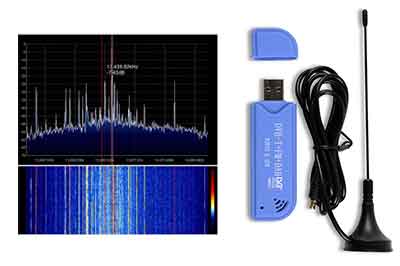Today we are going to see how to use a computer to receive radio frequency (RF) signals thanks to a simple and cheap DTT receiver that has the RTL2832U chip.
SDR programs, or Software Defined Radio, allow you to turn a computer into a radio frequency signal reception station, including wireless sensors, weather stations, and wireless controllers.
An SDR performs some of the tasks that are normally performed by the hardware of an RF receiver through software, avoiding the high cost of these components, with quite acceptable quality levels.
For this, we will simply need a DTT receiver with the RTL2832U chip and an R820T (Rafael Micro) as a tuner, which can be found for 6-7€ on eBay or AliExpress.
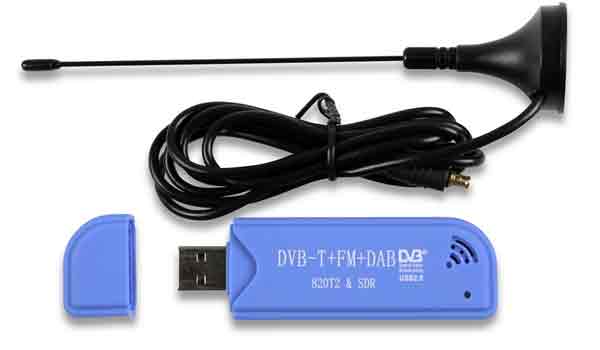
This small and cheap receiver, of which the image is one of several possible models, in its normal use serves to visualize DTT and radio channels on the computer.
But with a change of software we will be able to turn it into an RF receiver for a frequency range from 24MHz to 1850MHz, with a bandwidth of up to 3.2 MHz of sampling frequency, and compatible with modes AM, FM, WFM, NFM, USB, LSB, CW.
This covers almost the entire VHF and UHF range, with some of the frequencies that we can receive.
| Band | Mhz | Mode |
|---|---|---|
| Short wave | 24.5-28.5 | AM, USB, LSB, CW |
| Satellite | 29, 137, 145 | NFM, WFM, CW, SSB |
| AF | 87-108 | WFM |
| ATC | 118-134 | AM |
| Services (taxis, etc) | 137-174 | NFM |
| Marine band | 156-164 | NFM |
| 2m band | 144-148 | NFM |
| 70cm band | 430-440 | NFM |
| PMR (Walkies) | 446-446.1 | NFM |
| ISM band | 863-869.9 | NFM |
Just the subject of bands and modes would be enough for several entries. If you are interested, you can consult information about amateur radio. It is a broad and interesting world.
Installing SDRSharp
There are several compatible SDR software for the RTL2832U. Without a doubt the most popular is SDRSharp, which is a free software available on the website https://airspy.com/download/
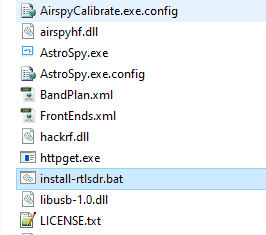
To install it, simply download the program file and unzip its contents. Next, run install-rtlsdr.bat to install SDRSharp.
Next, we need to replace the Windows drivers for the RTL2832U. To do this, we will use the Zadig program available at https://zadig.akeo.ie/
Download Zadig and run it as an administrator. Make sure to check “List all devices” in the options menu. Next, choose our device from the drop-down menu.
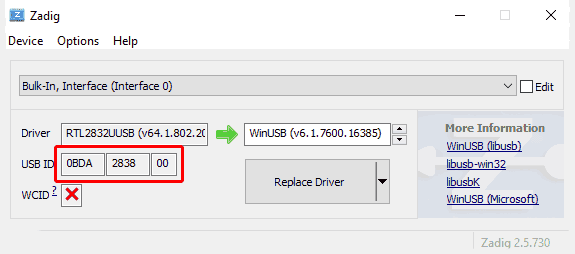
The name may vary, so make sure that the USB ID matches 0BDA:2838:00. Finally, click “Replace Driver” and wait for the program to replace the drivers.
Now we can launch SDRSharp. In the “Source” drop-down menu, choose RTL-SDR Usb. Next, click on the settings icon (the gear). In the window that appears, choose our USB device.
Now we can click on PLAY and we will see how we start to record radio frequency emissions.
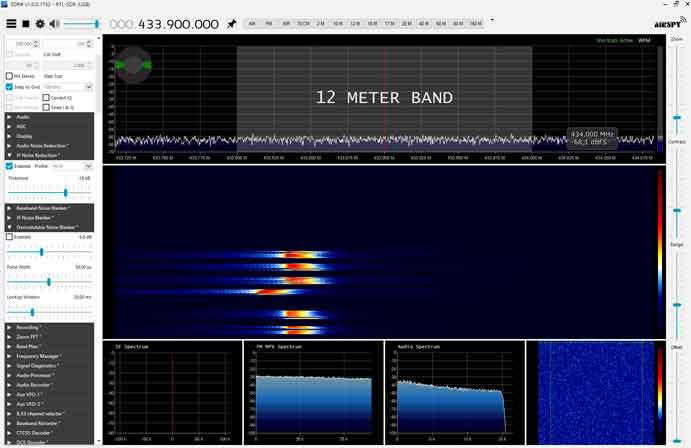
Now we can scroll to the frequency range of our environment, record and export the received emissions, and open them in another program. A simple audio editing program (like Audacity) may be sufficient to perform reverse engineering.
SDRSharp is a fairly extensive and powerful program, with a wide variety of options. For more information, consult the documentation on its website.
Conclusion
Being able to receive RF signals from the computer is a very interesting functionality in the #maker field. For example, it is a great tool to analyze the operation of wireless sensors and transmitters in the 433Mhz and 866Mhz bands.
With a simple DTT receiver with the RTL2832U chip and the appropriate software, we can have a fully functional analyzer for just 6-7€, with a noticeable quality, and a considerably wide range from 24MHz to 1850MHz.
We have seen how to use the RTL2832U with the SDRSharp program to visualize RF signals in our environment. Although it is a very interesting program, the reverse engineering process requires a certain effort.
In the next entry, we will see an alternative that will allow us to easily read 433Mhz signals from most wireless sensors and remote controls. See you soon!
